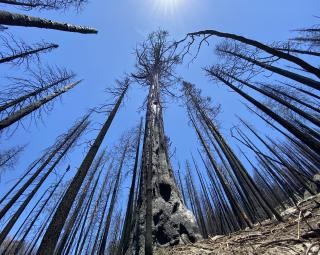Natural Resources
A critical part of the Forest Service mission is protecting and managing the national forests and grasslands so they best demonstrate the sustainable multiple-use management concept. Managing the natural resources of the Nation's forests and grasslands requires the complex integration of resource assessments, management actions, and cooperative partnerships.
Ecology

Facilitating the application of current ecological science to land and resource management on National Forests in California.
Packstock Center of Excellence

The Pack Stock Center of Excellence provides regional coordination for the efficient utilization of pack stock program resources to support the efforts of wilderness managers in preserving wilderness character.
Nature's Benefits

Forest ecosystems are human, plant, and animal life-support systems that provide a suite of goods and services vital to human health and livelihood—essentially Nature's Benefits, also called Ecosystem Services.
Inventory, Classification, and Mapping

The Pacific Southwest Region’s (R5) Vegetation Ecology program consists of three components: Inventory, Classification and Mapping.
Conservation Education

Conservation Education is a process of structured educational programs, experiences and/or activities that enable people to understand and appreciate our country’s natural resources and how to conserve them for future generations.
Natural Resource Manager

The Natural Resource Manager (NRM) is a database system used by the Forest Service to manage essential natural resource data. It provides access to information needed for management decisions.
An Emergency Response was approved by U.S. Forest Service Chief Randy Moore on July 22, 2022, to expedite the implementation of approximately 13,377 acres of fuels reduction treatments in 12 Giant Sequoia groves to reduce the wildfire risk that threatens these giant, iconic trees. The emergency fuels reduction treatments include hand cutting of brush and small trees, pulling duff away from the base of large Giant Sequoias, mechanical thinning, and prescribed burning.
These emergency actions make use of the agency’s existing authorities under the National Environmental Policy Act (NEPA) to conduct emergency fuels treatments as expeditiously as possible.
Giant Sequoia groves subject to the Emergency Response: Abbott, Bearskin, Belknap Complex, Black Mountain, Burro Creek, Grant, Indian Basin, Landslide, Long Meadow, Nelder, Silver Creek and Wishon.
Chief’s Decision Memorandum (PDF)
Implementation Updates (PDF)
July 2024
October 2023
July 2023
January/February 2023
November/December 2022
October 2022
September 2022
August 2022
News & Events
Sequoia National Forest News and Events, including Giant Sequoia Emergency Response
Forest Service Taking Emergency Action to Protect Giant Sequoias | USDA
Supporting Information
Part 1 of the Pacific Southwest Region (Region 5) Post-Fire Recovery Plan, Steps in Post-Fire Recovery, offers a concise description of the steps and actions the takes to recover National Forest System lands after a wildfire.
Part 2, The Post-Fire Recovery Action Plan (V.1) outlines actions taken to implement the Post-Fire Recovery Plan and provides a concise status update of the actions.
The Sierra Nevada Watershed Improvement Program (WIP) is a coordinated, integrated, collaborative program to restore the health of California's primary watershed through increased investment and needed policy changes.
This comprehensive effort is being organized and coordinated by the state's Sierra Nevada Conservancy (SNC) and the US Forest Service (USFS), in close partnership with additional federal, state, and local agencies, and diverse stakeholders.
Why do we need an improvement plan?
Sierra Nevada forests and watersheds are at a critical point. Failure to understand the urgency of the situation in the Sierra Nevada will have devastating impacts on California's economy and water supply. The potential for more megafires like the Rim Fire is high, and research demonstrates that, in many Sierra Nevada forests, there is a clear upward trend of larger, more intense fires.
A well-coordinated, comprehensive program that increases the pace and scale of restoration is essential to address the conditions that currently exist and are not going away.
The Sierra Nevada WIP will require significant efforts by many agencies, stakeholders and the public. The challenges to achieving the WIP's objectives are numerous, but at the same time the opportunity to build off of the consensus around the need act swiftly is substantial.
Our failure to seize this opportunity will have implications throughout California.
Latest information
Sierra Spotlight Digital Newsroom draws upon the regional knowledge and expertise of Sierra Nevada Conservancy (SNC) staff to highlight the most important restoration, scientific, and policy events in the Sierra Nevada Region






